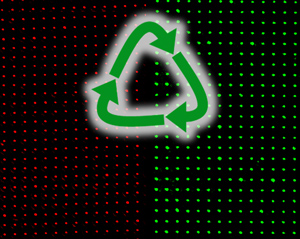A spot of light cleaning

Self-cleaning, reusable protein patterning templates have been fabricated using both nanoimprint and interferometric lithography. Adapted with permission from Ref. 1. Copyright 2015 American Chemical Society
Throw away the detergent and forgo the elbow grease: pesky proteins can now be removed from surfaces by simply exposing them to light, thanks to a reusable titania template developed by A*STAR researchers1.
Biologists have many reasons to pattern surfaces with proteins, from creating highly selective biosensors to studying fundamental processes such as tissue formation. What they don’t want, however, is for the proteins to stay on the surface indefinitely. Unfortunately, ridding a surface of proteins is a complicated and time-consuming task, which means that the majority of biologists typically throw away their substrates after a single use — leading to a high cost for consumables. Moreover, due to the complexity of fabrication systems, biologists usually outsource their chip manufacturing to engineers, which introduces delays and further exacerbates cost.
Karen Chong and her team at the A*STAR Institute of Materials Research and Engineering in Singapore recognized that these delays and costs could be avoided by designing a fabrication technique that non-engineers could use. “We wanted to demonstrate that fabrication and patterning techniques could move away from the traditional domains of microelectronics,” she recalls. “Specifically, we wanted to create fabrication techniques that could easily be adopted and replicated by biologists.”
Chong notes that to be practical, fabrication techniques must be either easy to use or have the potential to be scaled up to produce commercial quantities. Consequently, she and the team focused on two techniques: interferometric lithography for the former and nanoimprint lithography for the latter.
“Interferometric lithography techniques can be easily replicated by biologists without the need for a very complex or costly set-up in their laboratories,” she explains. “While nanoimprinting is not practical for smaller labs, it does allow us to scale up these samples into larger-area substrates.”
Both approaches yielded surfaces with titania nanostructures (see image) that were then covered with protein-resistant silanes. Exposure to ultraviolet light degrades the silanes, which allows proteins to adhere to the selected regions. After the protein-patterned substrates have served their purpose, Chong describes how “the proteins on the chips can be quickly removed, by just exposing the used substrates to ultraviolet light, without the need for elaborate cleaning methods.” The substrates can then be immediately reused without the need for further preparation.
“With the recyclable chip and the technique that we have demonstrated, fabrication techniques are no longer the exclusive domain of engineers,” remarks Chong.
The A*STAR-affiliated researchers contributing to this research are from the Institute of Materials Research and Engineering.
Reference
Moxey, M., Johnson, A., El-Zubir, O., Cartron, M., Dinachali, S. S. et al. Fabrication of self-cleaning, reusable titania templates for nanometer and micrometer scale protein patterning. ACS Nano 9, 6262–6270 (2015). | article
Media Contact
All latest news from the category: Life Sciences and Chemistry
Articles and reports from the Life Sciences and chemistry area deal with applied and basic research into modern biology, chemistry and human medicine.
Valuable information can be found on a range of life sciences fields including bacteriology, biochemistry, bionics, bioinformatics, biophysics, biotechnology, genetics, geobotany, human biology, marine biology, microbiology, molecular biology, cellular biology, zoology, bioinorganic chemistry, microchemistry and environmental chemistry.
Newest articles

An Endless Loop: How Some Bacteria Evolve Along With the Seasons
The longest natural metagenome time series ever collected, with microbes, reveals a startling evolutionary pattern on repeat. A Microbial “Groundhog Year” in Lake Mendota Like Bill Murray in the movie…

Witness Groundbreaking Research on Achilles Tendon Recovery
Achilles tendon injuries are common but challenging to monitor during recovery due to the limitations of current imaging techniques. Researchers, led by Associate Professor Zeng Nan from the International Graduate…

Why Prevention Is Better Than Cure—A Novel Approach to Infectious Disease Outbreaks
Researchers have come up with a new way to identify more infectious variants of viruses or bacteria that start spreading in humans – including those causing flu, COVID, whooping cough…



